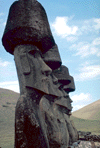|
Sedimentary rocks
Note: All pictures are meant
as guides only, as often the difference between one sedimentary rock
type and another is only in the size of the grains.
On the surface of the Earth, wind, water and ice weather and erode
away rocks, the particles of rock, minerals and the remains of plants
and animals. These transported particles eventually accumulate as sediments
in low lying areas such as beaches, lakes, rivers, seas or even the
bottom of the ocean.
Here the particles settle, compact under pressure and harden into sedimentary
rocks as they are buried under more and more sediment which accumulates
on top of them. This process may occur over thousands or even millions
of years and produce thicknesses of hundreds of metres of sedimentary
rocks.
 Of
all the different types of rock, sedimentary rocks are probably the
easiest to identify. They usually form in layers, are soft and easy
to scratch and tend to crumble more easily than other rock types. Fossils
- the remains of plants and animals - are only found in sedimentary
rocks. Of
all the different types of rock, sedimentary rocks are probably the
easiest to identify. They usually form in layers, are soft and easy
to scratch and tend to crumble more easily than other rock types. Fossils
- the remains of plants and animals - are only found in sedimentary
rocks.
Classification
Sedimentary rocks are classified according to how
they physically form. This is reflected in easily identifiable properties
such as composition and texture.
|



|
- Clastic rock is the most common
sedimentary rock formed from particles of mineral and rock.
Particles range in size from large boulders through sand to
fine silt and clay. Conglomerate and breccia form from compacted
gravel and boulders; sandstone is derived from compacted sand;
mudstone and shale form when fine silt and clay are compacted.
-
Organic rock forms from the
remains of living things. The most common examples are coal
(decayed remains of land plants) and limestone (calcium carbonate
remains of ocean organisms such as corals and shells).
- Chemical rock forms from minerals
as they come out of solution and crystallise. Examples include
rock salt (halite) and chert.
- Pyroclastic rock forms when
ash and boulders are blasted out of a volcano in an explosive
eruption and settle as sediments. Ash compacts to form tuff
whilst boulders form volcanic breccia.
The Easter Island statues where carved out of tuff.
- Residual rock forms when existing
rock is weathered where it sits removing some mineral components
whilst others are left behind. Some important minerals are formed
in this way, for example bauxite is formed in tropical climates
from when weathering removes other components, leaving iron
oxide behind.
|



|
|